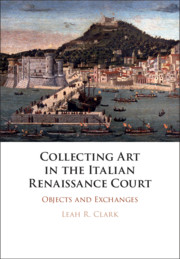Collecting Art in the Italian Renaissance Court
Objects and Exchanges
£90.00
- Author: Leah R. Clark, The Open University, Milton Keynes
- Date Published: June 2018
- availability: Available
- format: Hardback
- isbn: 9781108427722
£
90.00
Hardback
Other available formats:
eBook
Looking for an inspection copy?
This title is not currently available on inspection
-
In this book, Leah R. Clark examines collecting practices across the Italian Renaissance court, exploring the circulation, exchange, collection, and display of objects. Rather than focusing on patronage strategies or the political power of individual collectors, she uses the objects themselves to elucidate the dynamic relationships formed through their exchange. Her study brings forward the mechanisms that structured relations within the court, and most importantly, also with individuals, representations, and spaces outside the court. The volume examines the courts of Italy through the wide variety of objects - statues, paintings, jewellery, furniture, and heraldry - that were valued for their subject matter, material forms, histories, and social functions. As Clark shows, the late fifteenth-century Italian court an be located not only in the body of the prince, but also in the objects that constituted symbolic practices, initiated political dialogues, caused rifts, created memories, and formed associations.
Read more- Proposes a new view of the Italian court
- Offers new insight into possessions and Renaissance consumption habits
- Proposes a new hierarchy for the arts, looking at a range of media from gems to manuscript illumination, as well as painting and sculpture
Reviews & endorsements
'Clark shows that diplomatic, economic and dynastic links between fifteenth-century Italian Renaissance elites were sustained by the circulation of art objects: not just traditional paintings and sculptures, but objects of symbolic and material value as heraldic collars, jewels, furniture, and textiles. In their circulation as gifts between influence-brokers and powerful individuals, these prestige commodities acquire social and cultural biographies and sustain layers of complex interpretation that have a crucial bearing on the selfhood and agency of their owners. Clark's indispensable new study is especially to be welcomed for its attention to the court of Naples, neglected in anglophone scholarship, and here shown to be crucial to the statecraft of Ferrara and Florence.' Stephen Campbell, The Johns Hopkins University
See more reviews'In this illuminating book, Leah R. Clark shows that objects in princely collections did much more than reflect the magnificence of the ruler. Works of art in whatever media - including books, textiles, medals and gems as well as paintings and sculpture - interacted with each other in complex webs of intertextuality. As the fascinating case-studies indicate, the meaning of objects was inherently unstable. When given away, borrowed, bought, or pawned, they acquired shifting cultural dimensions. Their value was continually renegotiated through diplomacy, social display, or private study and contemplation, while their significance depended just as much on their dialogues with each other, and with their owners, as on their individual appearance, subject matter, materials and workmanship. This perceptive reinterpretation casts new light on the dynamics of court culture in the Italian Renaissance.' Deborah Howard, Professor Emerita of Architectural History, University of Cambridge
'Collecting Art in the Italian Renaissance Court: Objects and Exchange offers both scholars and students of art history an invaluable insight into the complex web of connections facilitated by a range of objects in Early Modern Italy - it is essential reading for anyone interested in the narratives built around art objects.' Marika Leino, Oxford Brookes University
'Clark's book is manifestly successful when it lets her strategically chosen case studies shine in their particularity. Her fine-grained research is new, and it demonstrates how objects could operate in different roles in Quattrocento Italy.' Gail Feigenbaum, Renaissance Quarterly
'Taking objects - as opposed to people - as her protagonists, Leah Clark proposes an innovative approach to the history of collecting art in fifteenth-century Italian courts … the scope of Clark's book reaches well beyond collecting.' Gail Feigenbaum, Renaissance Quarterly
Customer reviews
Not yet reviewed
Be the first to review
Review was not posted due to profanity
×Product details
- Date Published: June 2018
- format: Hardback
- isbn: 9781108427722
- length: 338 pages
- dimensions: 261 x 183 x 20 mm
- weight: 1.03kg
- contains: 57 b/w illus. 8 colour illus.
- availability: Available
Table of Contents
1. Carafa's testa di cavallo: the life of a bronze gifthorse
2. Practices of exchange: merchant bankers and the circulation of objects
3. Intertextuality and collection at the court of Ferrara: Roberti's Diptych
4. The Order of the Ermine: collars, cloaks, and the circulation of the sign.
Sorry, this resource is locked
Please register or sign in to request access. If you are having problems accessing these resources please email [email protected]
Register Sign in» Proceed
You are now leaving the Cambridge University Press website. Your eBook purchase and download will be completed by our partner www.ebooks.com. Please see the permission section of the www.ebooks.com catalogue page for details of the print & copy limits on our eBooks.
Continue ×Are you sure you want to delete your account?
This cannot be undone.
Thank you for your feedback which will help us improve our service.
If you requested a response, we will make sure to get back to you shortly.
×


